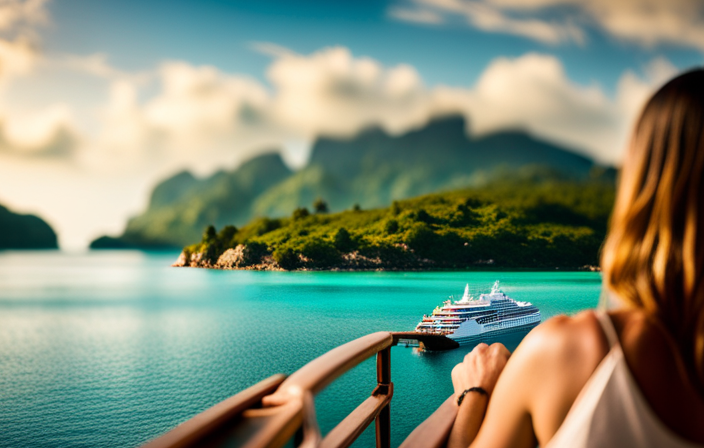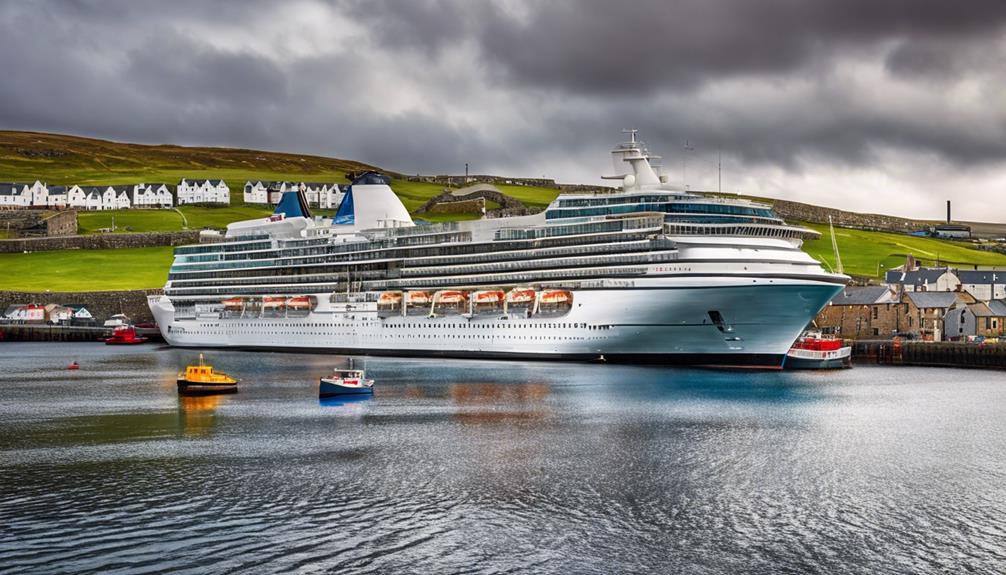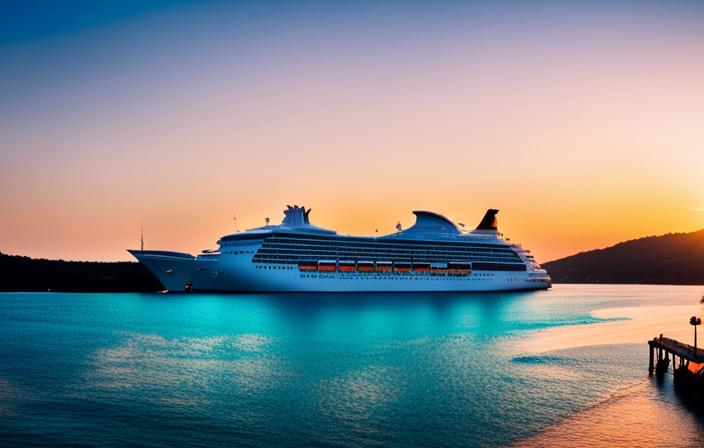On the deck of the cruise ship, as I observed the small boats in the distance gracefully gliding through the water, a feeling of excitement permeated the atmosphere. This was my introduction to the cruise ship’s tendering procedure, piquing my interest in its significance. Little did I realize, tendering would soon become a crucial aspect of my maritime adventure.
Tendering, in the cruise industry, refers to the process of transporting passengers from the ship to the shore and back, when the ship is unable to dock at a port. This can happen for a variety of reasons, such as shallow waters or limited docking space. Instead, the ship anchors offshore, and smaller vessels, known as tenders, are used to ferry passengers to and from the shore.
In this article, we will explore the ins and outs of tendering on a cruise, from how it works to the advantages and disadvantages. We will also dive into safety measures, etiquette, and provide tips for a smooth tendering experience.
So, grab your life jacket and let’s embark on this journey of discovery together.
Key Takeaways
- Tendering on a cruise refers to the process of using smaller boats to transport passengers to and from the ship when it cannot dock directly at the port.
- Tendering offers advantages such as flexibility to access smaller ports, a scenic approach for a unique vantage point, more privacy as fewer passengers disembark at once, and the opportunity to explore less crowded destinations.
- However, there are disadvantages to tendering, including potential delays, unfavorable weather conditions, limited accessibility for passengers with mobility issues, and the need for additional logistics and coordination.
- To have a smooth tendering experience, it is important to research and understand the process, come prepared with essentials and necessary travel documents, arrive early at the meeting point, and plan ahead to ensure a stress-free experience.
Definition and Purpose of Tendering on a Cruise
When you’re on a cruise, tendering is the process of using smaller boats to transport passengers from the ship to the shore when the ship cannot dock directly at the port. This tendering process allows passengers to explore destinations that are not accessible by larger ships.
One of the benefits of tendering is the opportunity to visit smaller, more intimate ports that are not equipped to handle larger vessels. This means you can discover hidden gems and experience a more unique and authentic side of the destination.
Additionally, tendering allows for a more personalized experience, as the smaller boats can navigate closer to the shore, providing stunning views and easier access to attractions.
Now, let’s delve into how tendering works and the logistics behind this process.
How Tendering Works
As passengers disembark from the ship, they are taken to shore via smaller boats, known as tenders, which are used to transport them to and from the port. The tendering process is an essential part of a cruise experience when the ship cannot dock directly at the port due to shallow waters or lack of docking facilities. To give you a visual understanding of how tendering works, imagine a bustling cruise ship anchored offshore, surrounded by a fleet of tenders shuttling passengers back and forth. The tenders can vary in size and capacity, accommodating anywhere from 50 to 300 passengers at a time. This ensures a smooth and efficient boarding process, allowing everyone to safely reach the port and explore their destination. Now, let’s delve into the reasons why cruise ships need to use tenders.
Reasons for Tendering
When it comes to tendering, there are several reasons why cruise ships opt for this method.
One reason is when ports have limited infrastructure, making it difficult for the ship to dock directly.
Another reason is when visiting remote or small islands that may not have a proper port for large cruise ships.
Lastly, tendering may be necessary in situations where the water is too shallow or the channels are too narrow for the ship to safely navigate.
These factors can add a sense of adventure and uniqueness to the cruise experience, as passengers get to explore these destinations in a more intimate way.
Ports with Limited Infrastructure
While visiting ports with limited infrastructure, passengers may need to use tender boats to get ashore. Interestingly, approximately 20% of all cruise ship ports require tendering. These ports often have limited access and transportation challenges, making it difficult for large cruise ships to dock directly at the port.
In such cases, tender boats are used to transport passengers from the ship to the shore. Tender boats are smaller vessels that can navigate shallow waters and reach areas where larger ships cannot. This allows passengers to explore and enjoy destinations that would otherwise be inaccessible.
Ports with limited infrastructure are often found in remote or small islands, where the natural beauty and unique culture await eager travelers.
Remote or Small Islands
Remote or small islands offer travelers the chance to immerse themselves in unique cultures and discover natural beauty that larger destinations often lack. These hidden gems of the sea provide an intimate and authentic experience.
Picture yourself stepping onto the shores of a remote island, surrounded by pristine turquoise waters and untouched white sandy beaches. The air is filled with the scent of exotic flowers, and the sound of tropical birds fills your ears. As you explore, you stumble upon lush jungles teeming with rare wildlife and breathtaking waterfalls cascading into crystal-clear pools.
The locals warmly welcome you, inviting you to try their traditional cuisine and join in their vibrant festivities. It’s a true escape from the ordinary, where time seems to stand still.
Now, let’s dive into the next section about shallow water or narrow channels.
Shallow Water or Narrow Channels
Navigating remote or small islands is just one challenge faced by cruise ships, but it’s not the only one. Another obstacle that can arise is dealing with shallow water or narrow channels.
As a captain, I must carefully maneuver the ship through these tricky passages to ensure the safety and comfort of our passengers. These shallow waters and narrow channels require precise navigation skills and constant monitoring of depth and width. It’s a delicate balance between avoiding any potential grounding and maintaining a smooth sailing experience.
This is where the use of tenders becomes essential, allowing us to transport passengers to and from the ship when we are unable to dock directly. But how exactly does boarding and disembarking the tender work? Let me guide you through this process smoothly and effortlessly.
Boarding and Disembarking the Tender
Boarding and disembarking the tender is a smooth and efficient process, allowing passengers to quickly explore the destination.
Did you know that on average, a cruise ship tender can transport up to 150 passengers at a time?
When it’s time to board the tender, passengers are typically given a tendering schedule that outlines departure times and locations. This ensures that everyone can plan their day accordingly.
As we approach the tender, crew members assist passengers in safely stepping onto the tender boat. Once onboard, there is ample seating available for a comfortable journey to shore.
The same process is followed when it’s time to disembark and return to the cruise ship. Safety measures and procedures are strictly followed throughout the boarding and disembarking process, ensuring a secure and hassle-free experience for all passengers.
Safety Measures and Procedures
Throughout the entire process of boarding and disembarking the tender, strict safety measures and procedures are in place to ensure a secure and hassle-free experience for all passengers. From the moment we step onto the tender, we can rest assured that our safety is a top priority. The crew undergoes extensive training to handle any emergency situation that may arise during the journey. They are equipped with the necessary knowledge and skills to ensure our well-being. Additionally, safety precautions such as life jackets and emergency exits are readily available and clearly marked on the tender. These measures provide peace of mind as we navigate the waters. As we transition into the next section about time management and planning, it’s important to note that safety remains paramount throughout our entire cruise experience.
Time Management and Planning
To make the most of your trip, managing your time wisely and planning ahead will ensure a smooth and enjoyable experience.
Time management is crucial on a cruise, as there are often limited hours at each port of call. It’s important to prioritize the activities and attractions you want to experience and create a schedule that allows you to make the most of your time.
Researching the port destinations beforehand can also help you plan your day effectively. Additionally, taking into account the ship’s schedule and any tendering times can help you avoid any unnecessary rush or delays.
By carefully planning your time, you can maximize your cruise experience and ensure that you don’t miss out on any must-see sights or activities.
As we move into the next section about tendering etiquette, it’s important to remember the importance of being considerate and respectful of other passengers.
Tendering Etiquette
Mind your manners when maneuvering through the process of getting off the ship and onto smaller boats, as tendering takes tact and thoughtfulness. It’s important to follow proper tendering etiquette to ensure a smooth and enjoyable experience for everyone involved. First, be mindful of your fellow passengers and avoid pushing or shoving to get onto the tender boat. Wait patiently for your turn and maintain a calm demeanor. Secondly, dress appropriately for the occasion. While there may not be a strict dress code, it’s best to avoid overly casual attire such as swimwear or flip flops. Opt for comfortable yet presentable clothing that respects the formal atmosphere of the cruise. Remember, being courteous and considerate goes a long way in creating a positive tendering experience. Transitioning into the next section, let’s now explore the advantages and disadvantages of tendering.
Advantages and Disadvantages of Tendering
Tendering etiquette is important to ensure a smooth and enjoyable experience for everyone on board a cruise ship. However, it’s also essential to consider the advantages and disadvantages of tendering.
Advantages:
- Flexibility: Tendering allows ships to access smaller ports that are unable to accommodate larger vessels.
- Scenic approach: Tender boats offer a unique vantage point, allowing passengers to appreciate the beauty of the surrounding area as they approach the shore.
- Privacy: Tendering can provide a more intimate experience, as fewer passengers disembark at once.
- Exploration: Passengers have the opportunity to explore smaller, less crowded destinations that may not be accessible by larger ships.
- Unique experiences: Tendering can lead to unexpected encounters with marine life or local culture.
Disadvantages:
- Delays: Tendering can be time-consuming, especially when there are many passengers to transport.
- Rough seas: Unfavorable weather conditions can make tendering a bumpy and uncomfortable experience.
- Limited accessibility: Some passengers with mobility issues may find tendering difficult or impossible.
Transition: Now that we understand the advantages and disadvantages of tendering, let’s move on to some tips for a smooth tendering experience.
Tips for a Smooth Tendering Experience
Transitioning to the topic of tips for a smooth tendering experience, it’s important to keep in mind a few helpful suggestions. When it comes to tendering, smooth sailing is all about efficient logistics. To ensure a hassle-free experience, here are some tips to consider:
-
Plan ahead: Research the tendering process for your specific cruise line and destination. Know the schedule and requirements beforehand to avoid any surprises.
-
Be prepared: Bring essentials like sunscreen, water, and snacks, as well as any necessary travel documents. Don’t forget to wear comfortable shoes for walking on the tender boat.
-
Arrive early: Get to the designated meeting point with plenty of time to spare. This will help you avoid long queues and ensure a smoother boarding process.
Remember, a little preparation goes a long way in ensuring a stress-free tendering experience. Looking ahead, let’s explore alternatives to tendering and future trends in the cruising industry.
Alternatives to Tendering and Future Trends
Now, let’s dive into the exciting world of cruising and explore the innovative alternatives and future trends that are revolutionizing the way we embark and disembark from ships.
Cruise ship technology is constantly evolving to enhance the guest experience and provide efficient solutions for tendering.
One alternative to traditional tendering is the use of docked piers, which allow passengers to simply walk on and off the ship.
Another trend is the introduction of tendering platforms, where smaller boats can dock alongside the ship, eliminating the need for guests to transfer to a tender vessel.
Additionally, some cruise lines are investing in advanced tendering systems, such as floating platforms or even seaplanes, to transport passengers directly to shore.
These advancements not only provide convenience and speed for passengers, but also have a positive impact on local economies by increasing tourism and boosting local businesses.
Frequently Asked Questions
How long does it typically take to board a tender from the cruise ship to the shore?
It usually takes around 10-15 minutes to board a tender from the cruise ship to the shore. The boarding process is efficient and organized, with the tender capacity being carefully managed to ensure a smooth transfer for all passengers.
Are there any age restrictions for passengers boarding the tender?
Age restrictions for passengers boarding the tender vary depending on the cruise line. Typically, children must be accompanied by an adult, and some cruise lines have minimum age requirements. The boarding process is usually organized and efficient.
Can passengers with mobility issues or disabilities board the tender?
Passengers with mobility issues or disabilities can board the tender on a cruise ship. The boarding process takes into account accessibility requirements, ensuring that everyone can comfortably and safely access the tender.
Are there any additional costs associated with tendering?
Yes, there may be additional fees associated with the tendering process on a cruise. These fees can vary depending on the cruise line and destination. It’s important to check with your cruise line for specific information on these costs.
What happens if the weather conditions are not suitable for tendering?
If the weather conditions are not suitable for tendering, alternatives such as docking at a different port or staying at sea may be considered. Safety precautions, like monitoring the weather and maintaining communication, are essential during tendering.
Conclusion
In conclusion, tendering on a cruise is an essential process that allows passengers to visit ports that are unable to accommodate large cruise ships. It offers a unique opportunity to explore smaller, more secluded destinations. Some might argue that the inconvenience of tendering outweighs the benefits, but it is important to remember that these destinations often offer a more authentic and less crowded experience.
So next time you find yourself tendering, embrace the adventure and enjoy the hidden gems that await you ashore.










